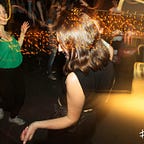How Netflix is Saving Yiddish
Written to the song: Gris— J. Balvin
“Words should be weighed, not counted” — Yiddish Proverb
We have all been spending our time binging on Netflix shows, although despite the drama surrounding Joe Exotic, one show is doing something special — it’s saving the Yiddish language.
The Netflix show Unorthodox follows the story of Esty, who has the desire to flee her ultra-orthodox Jewish community, known as the “Satmar Jews”. This specific Jewish community is known for being very strict with their customs, relationships and for maintaining the Yiddish language. The four part-series follow Esty’s transition from traditional ultra-orthodox wife in Williamsburg to living a “free” life in Berlin. While the story reveals many layers and problematic expectations within the community, one underlying and recurrent theme — is the connection to the Yiddish language.
A language is considered “endangered” if the community that speaks the language is at risk of prospering due to assimilation, genocide or factors displacing the community (Crystal, 2006). Prior to the Holocaust, it was estimated that there were over 10.5 million Yiddish speakers, although, after the Holocaust, Yiddish was considered to be endangered as it was estimated for there to only be 3 million speakers left (YIVO, 2014). Prior to the War, various dialects of Yiddish were spoken in Jewish communities throughout Europe. Although after the Holocaust, the Jews that survived had a desire to integrate and blend in with their new homes — whether that be in Europe, North or South America. As the survivors had children, even if they maintained their Yiddish language often their children grew up speaking their home country’s native language. A declining number of speakers coupled with a speaking community consisting of the aging population lead to Yiddish becoming an endangered language, a language that is threatened to be extinct. Although there is one community keeping the language alive and thriving — the Satmar community, highlighted in the Netflix show. Unorthodox showed the community conversing mainly in Yiddish, and even having trouble expressing themselves in English. The community also uses anglicisms (English words) for objects which don’t have an assigned word in Yiddish, showing how the language is not being modernized. The characters in Berlin even approach the main character, Esty, asking her “if you’re from New York, what’s your accent then?” This comment demonstrates how insular the community is and the emphasis on tradition and saving the Yiddish language. Viewers of the show were exposed to the language which fuses both German and Hebrew. Will this encourage people to learn more about the language?
As most Yiddish speakers are of the elderly population or within the insulated ultra-orthodox community. There is a wave of people who want to study to preserve the language. While people can be exposed to Yiddish through Yiddish music and theatre, this isn’t accessible to everyone. But something becoming more and more accessible is Netflix. Most people subscribe to Netflix and if not, they use their friend’s account. Netflix chose to feature a show in Yiddish does not only show diverse communities but rather preserves a language with so much deep history. I hope that this show encourages more people to pick up Yiddish, to re-connect to their heritage and ensure that the language grows in speakers and can be brought back to life.
While it is hard to bring back a dying language, it is possible. If a community can recognize that their language is dying, they can take the necessary actions to save it. Languages can be saved by recording the language, transcribing it and documenting through films, books, and dictionaries.
Sources:
“Basic Facts About Yiddish.” YIVO Institute for Jewish Research, www.yivo.org/cimages/basic_facts_about_yiddish_2014.pdf?c=.
Crystal, David. How Language Works: How Babies Babble, Words Change Meaning, and Languages Live or Die. Woodstock, NY: Overlook, 2006. Print.
